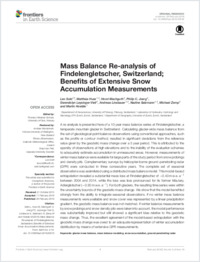Mass balance re-analysis of Findelengletscher, Switzerland; benefits of extensive snow accumulation measurements
- Sold, Leo Departement of Geosciences, University of Fribourg, Switzerland
- Huss, Matthias Departement of Geosciences, University of Fribourg, Switzerland - Laboratory of Hydraulics, Hydrology and Glaciology, ETH Zurich, Switzerland
- Machguth, Horst Department of Geography, University of Zurich, Switzerland
- Joerg, Philip C. Department of Geography, University of Zurich, Switzerland
- Leysinger Vieli, Gwendolyn Department of Geography, University of Zurich, Switzerland
- Linsbauer, Andreas Departement of Geosciences, University of Fribourg, Switzerland - Department of Geography, University of Zurich, Switzerland
- Salzmann, Nadine Departement of Geosciences, University of Fribourg, Switzerland - Department of Geography, University of Zurich, Switzerland
- Zemp, Michael Department of Geography, University of Zurich, Switzerland
- Hoelzle, Martin Departement of Geosciences, University of Fribourg, Switzerland
-
29.02.2016
Published in:
- Front. Earth Sci. - Cryospheric Sciences. - 2016, p. 18
English
A re-analysis is presented here of a 10 year mass balance series at Findelengletscher, a temperate mountain glacier in Switzerland. Calculating glacier-wide mass balance from the set of glaciological point balance observations using conventional approaches, such as the profile or contour method, resulted in significant deviations from the reference value given by the geodetic mass change over a 5 year period. This is attributed to the sparsity of observations at high elevations and to the inability of the evaluation schemes to adequately estimate accumulation in unmeasured areas. However, measurements of winter mass balance were available for large parts of the study period from snow probings and density pits. Complementary surveys by helicopter-borne ground-penetrating radar (GPR) were conducted in three consecutive years. The complete set of seasonal observations was assimilated using a distributed mass balance model. This model-based extrapolation revealed a substantial mass loss at Findelengletscher of −0.43 m w.e.a⁻¹ between 2004 and 2014, while the loss was less pronounced for its former tributary, Adlergletscher (−0.30 m w.e.a⁻¹). For both glaciers, the resulting time series were within the uncertainty bounds of the geodetic mass change. We show that the model benefited strongly from the ability to integrate seasonal observations. If no winter mass balance measurements were available and snow cover was represented by a linear precipitation gradient, the geodetic mass balance was not matched. If winter balance measurements by snow probings and snow density pits were taken into account, the model performance was substantially improved but still showed a significant bias relative to the geodetic mass change. Thus, the excellent agreement of the model-based extrapolation with the geodetic mass change was owed to an adequate representation of winter accumulation distribution by means of extensive GPR measurements.
- Faculty
- Faculté des sciences et de médecine
- Department
- Département de Géosciences
- Language
-
- English
- Classification
- Hydrology
- License
-
License undefined
- Identifiers
-
- RERO DOC 258856
- DOI 10.3389/feart.2016.00018
- Persistent URL
- https://folia.unifr.ch/unifr/documents/304766
Statistics
Document views: 110
File downloads:
- pdf: 155
